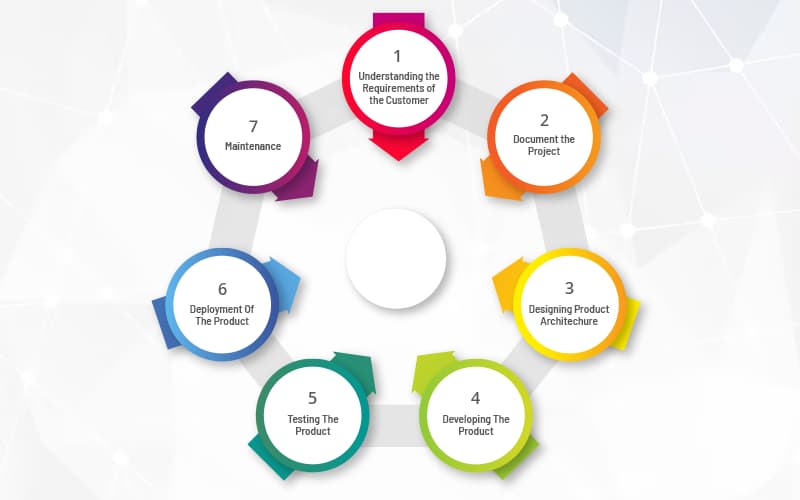It is essential to develop software systematically to provide a quality IT solution within a specified time and budget. The software development life cycle encourages IT teams to do so! The whole software development process will be chaotic if no path is defined.
As the name implies, the software development life cycle defines the complete picture of software production, from understanding its goals to testing and deployment. It is the process or plan that software development undergoes to achieve the best quality and efficiency at a low cost in the shortest time.
SDLC aims to draft a well-structured flow of software development phases to produce high-quality software. Interested in finding out the details? Here is a complete guide that will help you through SDLC.
What is the Software Development Life Cycle (SDLC)?
The Software Development Life Cycle (SDLC) is a process every software organization follows in designing and deploying software. It is a detailed plan that describes how to develop, test, alter, deploy, and maintain a software product. It defines the complete methodology for improving the software product's features to get the best results for your business.
Different Phases of SDLC

An SDLC typically consists of different phases, each representing a distinct point in the software development process. While different methodologies might have variations in the specifics of these processes, the core concept remains relatively the same.
Let’s us understand each of these phases:
- Understanding the Requirements of the Customer
Requirement analysis is the first phase of the software life cycle, where the development team chalks out the customers' requirements. The senior members of the team usually do it. They take input from the customers, sales department, and domain experts in the industry. A market survey is also done before finalizing the requirements.
After noting all the requirements, a plan for the basic project approach is made. Also, a product feasibility study is conducted in the economic, operational, and technical areas. It includes identifying risks, understanding different technical approaches, and ensuring the quality that one needs to follow to successfully implement the project with the minimum of risks.
- Document the Project
Once all the requirements are understood, proper documentation is done. The document is known as the SRS (software requirement specification) document. SRS defines the product requirements and is sent to the customer for approval. You can also send it to the market analyst for final approval. Designing Product Architecture
SRS is a reference for product architects to design the architecture of the software. Based on the same SRS document, they usually come up with 2-3 architecture ideas that fulfill all the software requirements. These design approaches for the product architecture are documented and then proposed, along with the time and budget required to execute the design. The document is now known as DDS (design document specification).All the important stakeholders review the proposed 2-3 DDS and choose one out of them. The stakeholders decide based on various parameters, for example, risk associated with the project, robustness of the software, software design modularity, time required, total project cost, and budget.
After picking a DDS for the project, it now clearly defines all the architectural modules of the product. Also, communication and data flow diagrams are made with external and third-party modules (if any).
Developing The Product
In this phase, product development starts. Programmers code the software as per the finalized DDS. Since all the details are well planned, the coding is executed without much hassle.Programmers follow coding guidelines defined by their organization. As per the DDS, they can use the following languages: C, C++, Pascal, Java, PHP, or any other programming language to write the software code. Also, they use different tools like interpreters, compilers, and debuggers to execute their tasks.
We recommend that you choose the programming language that best suits the features of your product.
- Testing The Product
It is the subset of every phase where the software product is tested after every iteration. However, a benchmark is set where product defects are reported, tracked, fixed, and retested. The product is improved until the standard quality is achieved, as defined in the SRS document. Deployment Of The Product
Once the product is tested, it can be deployed in the market. An official date is set in the appropriate market for the product launch. Also, one can choose to launch the product with a limited audience and take their feedback before launching it to the market. Based on their suggestions, you can improve the product. The process is known as user acceptance testing (UAT).Based on UAT, the product may be released as it is or with suggested enhancements in the targeted market segment.
- Maintenance
After the product's release in the market, it should be maintained. It also includes timely upgrades and changes as required from time to time. If customers face any issues, the maintenance team fixes them.
Benefits of Software Development Life Cycle
SDLC breaks up the complex and tedious software development task into easy-to-understand and easy-to-execute steps. While this structure has countless benefits, we have listed the top 5.
- SDLC defines what our problem or goal is. It is imperative when you are taking on a huge software project. You can chalk out solutions only after understanding the problem or product’s goal. With SDLC, you can implement the plan with precision and relevance.
- It brings clarity to the project. Each team member is assigned well-documented work. They also submit the report after completing the assigned task. All this process leaves no room for misunderstandings or confusion, leading to better project quality. The project manager reviews the work of each phase and then passes the software development to the second phase.
- The product is tested correctly before installation. Bugs are timely fixed, and it saves you from all the chaos.
- The project manager can easily manage the project as everything is formally documented.
- The customer’s opinion is considered both at the project's start and delivery. SDLC model allows the project to tailor the products to the customer's requirements.
Key Tips From Innoraft
The quality of the software product is the best advantage in a competitive environment. The better the quality, the higher your sales and revenue will be. Here are our tips for building good-quality software products and getting the best for your business.
- You should design the product with the customer's view in mind.
- Software should have a good UX (user experience) design. Customers must find your product easy to understand and use.
- The software should be flexible enough to integrate with other tools and technologies. It allows your software product to have a huge scope for future improvements.
- Access the market properly while starting the SDLC project. You can find out about customers’ needs and preferences.
- It would be best if you used modern technologies for SDLC.
Conclusion
SDLC describes the steps to follow that not only complete the software development but also ensure it is done in less time. It aims to deliver the best software solution in a time-bound manner at minimal cost. SDLC ensures that customer feedback is taken into account and that the project leads to client satisfaction.
If you, too, are thinking of building software for your business but lack expertise in the task, contact the Innoraft team for services! We are a B2B web development company with many years of experience. We also ensure 24-hour technical customer support.
FAQ
Frequently Asked Questions
Didn’t find what you were looking for here?
